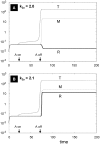An in silico modeling approach to understanding the dynamics of sarcoidosis
- PMID: 21637752
- PMCID: PMC3103504
- DOI: 10.1371/journal.pone.0019544
An in silico modeling approach to understanding the dynamics of sarcoidosis
Abstract
Background: Sarcoidosis is a polygenic disease with diverse phenotypic presentations characterized by an abnormal antigen-mediated Th1 type immune response. At present, progress towards understanding sarcoidosis disease mechanisms and the development of novel treatments is limited by constraints attendant to conducting human research in a rare disease in the absence of relevant animal models. We sought to develop a computational model to enhance our understanding of the pathological mechanisms of and predict potential treatments of sarcoidosis.
Methodology/results: Based upon the literature, we developed a computational model of known interactions between essential immune cells (antigen-presenting macrophages, effector and regulatory T cells) and cytokine mediators (IL-2, TNFα, IFNγ) of granulomatous inflammation during sarcoidosis. The dynamics of these interactions are described by a set of ordinary differential equations. The model predicts bistable switching behavior which is consistent with normal (self-limited) and "sarcoidosis-like" (sustained) activation of the inflammatory components of the system following a single antigen challenge. By perturbing the influence of model components using inhibitors of the cytokine mediators, distinct clinically relevant disease phenotypes were represented. Finally, the model was shown to be useful for pre-clinical testing of therapies based upon molecular targets and dose-effect relationships.
Conclusions/significance: Our work illustrates a dynamic computer simulation of granulomatous inflammation scenarios that is useful for the investigation of disease mechanisms and for pre-clinical therapeutic testing. In lieu of relevant in vitro or animal surrogates, our model may provide for the screening of potential therapies for specific sarcoidosis disease phenotypes in advance of expensive clinical trials.
Conflict of interest statement
Figures







References
-
- Iannuzzi MC, Rybicki BA, Teirstein AS. Sarcoidosis. N Engl J Med. 2007;357:2153–65. - PubMed
-
- Yates A, Callard R, Stark J. Combining cytokine signaling with T-bet and GATA-3 regulation in Th1 and Th2 differentiation: a model for cellular decision-making. J Theor Biol. 2004;231:181–96. - PubMed
-
- Mariani L, Lohning M, Radbruch A, Hofer T. Transcriptional control networks of cell differentiation: insights from helper T lymphocytes. Prog Biophys Mol Biol. 2004;86:45–76. - PubMed
-
- Mendoza L. A network model for the control of the differentiation process in Th cells. Biosystems. 2006;84:101–14. - PubMed
Publication types
MeSH terms
Substances
LinkOut - more resources
Full Text Sources
Medical

